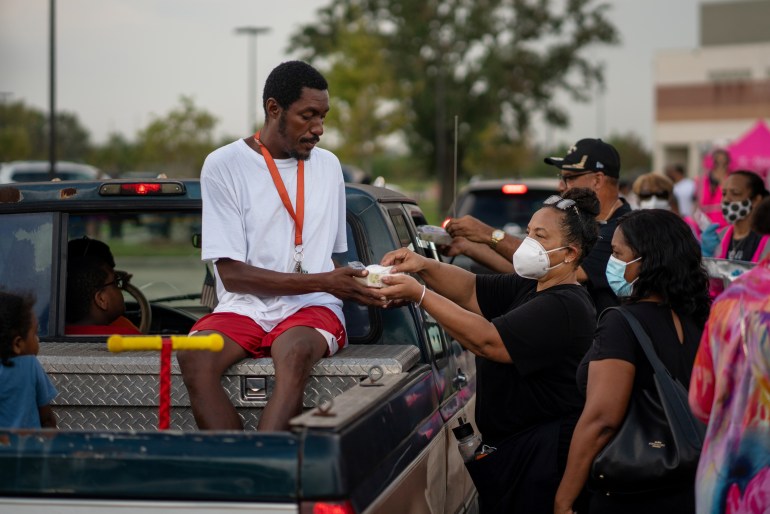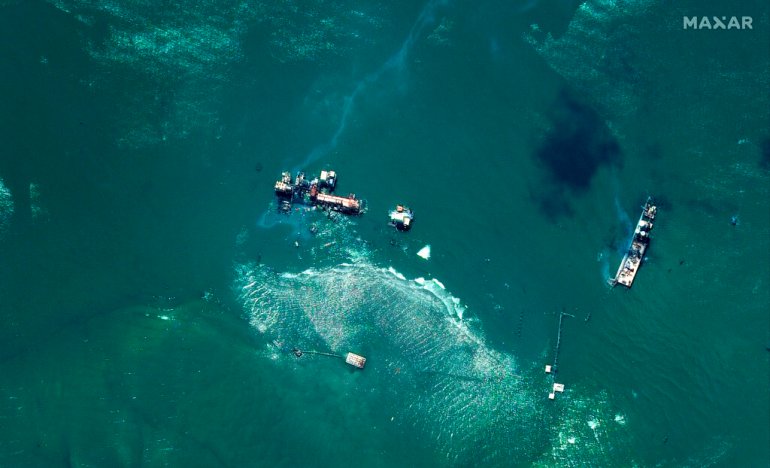New Orleans slowly returns to life amid Hurricane Ida devastation
Power returns to city but rural areas still suffer after Category 4 hurricane delivers 240km/h punch.

Sid Padil, visiting from San Francisco, was surprised by the devastation and swaths of blue tarps on roofs in the southern United States city of New Orleans, Louisiana which is slowly coming back to life after Hurricane Ida punched through with extreme winds nearly two weeks ago.
Padil was checking on gas stations and convenience stores he owns in Louisiana and Mississippi. He had a hard time finding a place to eat, and when he did, the patrons were mostly locals and recovery workers.
Keep reading
list of 4 itemsIn Pictures: Long road to recovery after hurricane Ida
US: Hurricane Ida death toll rises as recovery efforts continue
Biden on tour of two states heavily affected by Hurricane Ida
“I don’t see many tourists right now,” Padil told The Associated Press.
On Bourbon Street in the heart of New Orleans, supply trucks are once again delivering beer and the landmark Cafe Du Monde is serving beignets – fried pastries covered with white sugar – even though there are not many tourists or locals around to partake of either.
Almost all the power is back on in New Orleans and the city of 1.3 million is showing signs of making a comeback from the Category 4 storm that packed 240-km/h (150-mph) winds and is blamed for more than two dozen deaths in Louisiana.
More businesses are opening daily, gasoline is easier to find and many roads are lined with huge debris piles from cleanup work.
But thousands are still struggling without electricity and water outside the metro area, and officials say oppressive heat is contributing to both health problems and misery. It could still be weeks before power is restored in some areas, and many residents who evacuated have not returned.
“It is not lost on anybody here at the state level and certainly not on our local partners just how many people continue to suffer,” Louisiana Governor John Bel Edwards said on Thursday.
“While things are getting better and we can be thankful for that … this is going to be a very long-term recovery.”

But more than 270,000 homes and businesses remained without power, according to the Louisiana Public Service Commission.
In Jefferson Parish, outside the city, 46,000 homes and businesses were still without electricity, Phillip May, chief executive of Entergy Louisiana, the state’s largest power provider, said on Thursday.
Progress is being made in hard-hit places including LaPlace, a town in St John the Baptist Parish where service was restored to a hospital, May said.
Other parts of the Louisiana’s healthcare network, which was slammed with COVID-19 cases before the storm, are struggling. Executives of Ochsner Health System, Louisiana’s largest care provider, estimated it would take about four weeks to get two of its damaged hospitals fully operational.
“Heat illness is a big concern,” said Dr Robert Hart, Ochsner’s chief medical officer. Hart said emergency rooms had seen several patients stricken by carbon monoxide, a common problem after big storms as people use gas-powered generators for electricity, sometimes indoors.
About three-quarters of US oil and gas production in the Gulf of Mexico remains offline after Ida forced oil companies to evacuate and shut down offshore platforms, according to a report in the Houston Chronicle newspaper.
Several refineries and petrochemical plants remain shuttered without power and no timeline to restart production. Other oil and gas producers suffered extensive damage from Ida’s 150mph (240km/h) winds, the report said.
Around New Orleans, progress was visible as lights came back on and piles of debris lined the streets. Residents returning home were stacking up wet mattresses, fractured lumber, tree limbs and other storm refuse along curbs.

The company overseeing the response to a large oil spill spurred by Hurricane Ida said that a containment dome had been placed over a broken undersea pipeline, stemming the flow into the Gulf of Mexico.
Houston-based Talos Energy said in a statement that its oil spill response contractor had installed the containment dome on the evening of September 6, allowing for the recovery of the oil coming from the sheared-off 30cm-diameter (1-foot-diameter) pipe and transferring it to surface vessels.